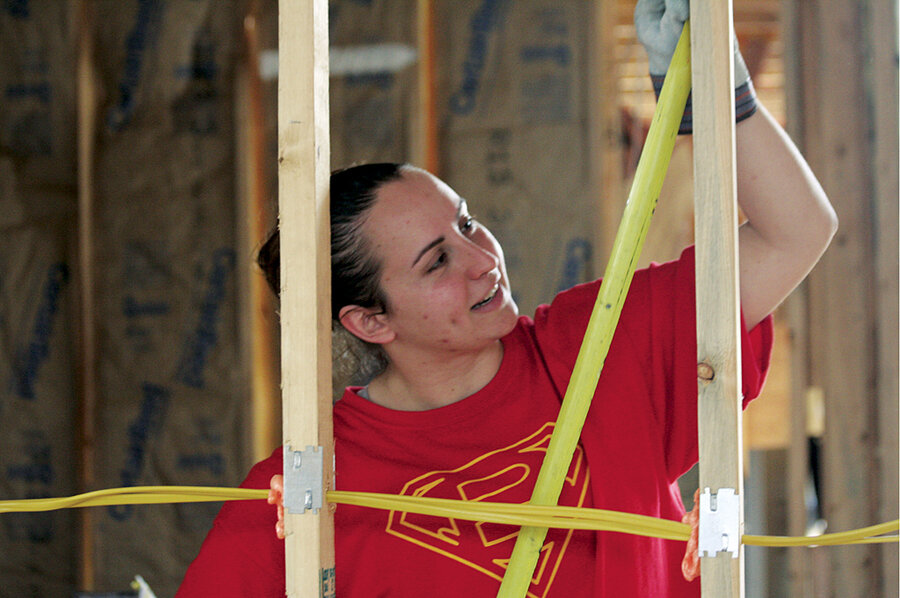Helping New Orleans make a comeback is her personal passion
Loading...
| New Orleans
It was more than a year after hurricane Katrina swept through the Gulf region in 2005 and the floodwaters receded from the Lower Ninth Ward when Brittany Aydelotte first joined the relief effort in New Orleans.
Thousands of residents had been displaced; many parts of the city still resembled a disaster area. Ms. Aydelotte, then a student at The College of New Jersey in Ewing, had organized a service trip for fellow students.
But what began as a desire to help a city in desperate need has become a long-term personal passion.
Aydelotte, now 25, is a senior program coordinator for the Bonner Center for Civic and Community Engagement at The College of New Jersey, a service and scholarship program that mobilizes students around community needs.
Prior to graduating and being hired by the center, Aydelotte was part of a team of students who dedicated 300 hours a year to promoting a spirit of service on campus.
On a frigid afternoon in January, Aydelotte was installing insulation in a New Orleans home with a group of students. It was her 10th trip to the city since early 2007 – she has spent almost all of the visits participating in rebuilding projects in every corner of the city.
She has also planned and conducted trips to the region for more than 200 students, and has grown to love and admire New Orleans and its residents.
A large part of her passion for helping came from Kentucky Street resident Laura Ward, the first homeowner in New Orleans that she helped, Aydelotte says.
She recalls an afternoon when Mrs. Ward made lunch for Aydelotte's team of volunteers and shared the story of how she was separated from her son in the frantic evacuation that followed Katrina.
Ward also told the students how grateful she was for their support.
"It was really powerful how grateful she was," Aydelotte recalls. "It definitely contributed to my drive to keep coming back."
To this day, Ward remembers Aydelotte and the work she did on her house.
"She was really a blessing for me," Ward says. "For some reason we all just clicked, and she just fell into our family."
When many people think of New Orleans, they think of its challenges, such as crime, Ward says. Aydelotte "was just one who overlooked it," she says. "She came because she realized that people needed help."
Aydelotte has worked to share her love for the city with her students.
"I want them to make the same connections to the people and the city that I have made," Aydelotte says.
"Whether we are here putting up drywall, painting, sorting Mardi Gras beads, or pulling nails out of wood, everybody can take back lessons about connecting with people – and remember that just because something happened a long time ago, [it] doesn't mean it has been fixed," she says.
The first-time visitors she brings to New Orleans are moved when they see the lack of progress that has been made in rebuilding parts of the city, she says. Even today, entire blocks that used to be filled with occupants are entirely vacant.
As news about the city and its needs has slowly receded from the headlines, Aydelotte says, many people have forgotten about New Orleans and hurricane Katrina.
But volunteers, she says, continue to make a difference for the city.
"Volunteers have played a very important role in rebuilding New Orleans," she says. "They are reminding people that [the city] is still not back, letting others know about what needs to be done here."
Aydelotte's passion for rebuilding the city has rubbed off on sophomore Kayla Simpkins, who has been on three service trips to New Orleans and was a student coordinator for a recent winter trip.
"You can drive down any street, through any part of the city, and [Aydelotte] can tell you a story about it," Ms. Simpkins says. "I saw her leadership and how she inspired other groups, and I wanted to do the same for incoming freshmen."
Aydelotte's mission far surpasses a simple desire to do a service project, Simpkins says. "She is not just going down to do relief work," Simpkins says. "She is really invested in the city and cares a lot about it."
In fact, Aydelotte has considered moving to New Orleans.
"I love the people and the culture of the city the most, and the rebuilding efforts are certainly something that I am passionate about," she says.
While Aydelotte may not be ready to move, the Cinnaminson, N.J., native relishes the opportunity to bring 30 or 40 students to the city each year, introducing them to a fascinating place and fostering in them a love for the city – and for serving others – that mirrors her own.
One powerful moment for her is when she hears students talk about the people they meet in New Orleans. "I have begun to feel everyone else's passion – on top of my own – for the city," she says.
• For more about the Bonner Center for Civic and Community Engagement, visit bonner.pages.tcnj.edu.
• Sign up to receive a weekly selection of practical and inspiring Change Agent articles by clicking here.






